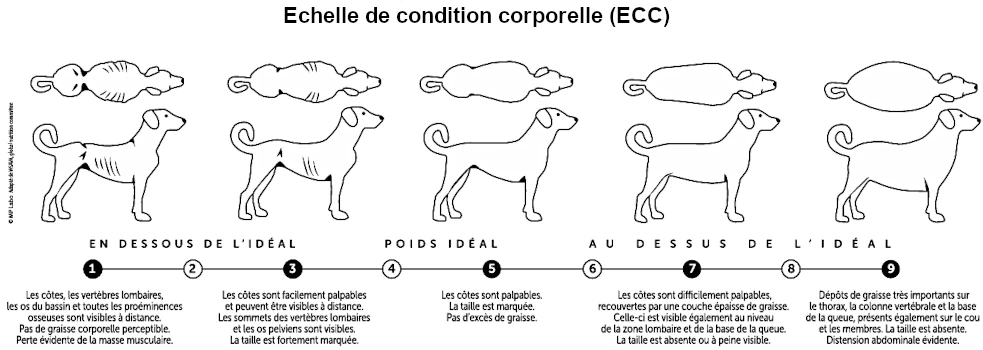Your Dog’s Weight: Too Light or Too Heavy?
It is essential to ensure that your dog maintains a healthy weight to guarantee their quality of life and prevent various health issues. This article will help you identify if your dog is overweight or underweight and provide solutions to address it.
If no solution works, do not forget to consult a veterinarian, especially if the weight change is significant, to evaluate any potential medical causes.
Why is it important to monitor your dog's weight?
Your dog's weight is a key indicator of their health. Excess weight can lead to diseases such as diabetes, joint problems, or heart issues, while insufficient weight can signal nutritional deficiencies or underlying medical disorders.
How to evaluate your dog's ideal weight?
The ideal weight varies depending on your dog's breed, size, and age. Here are some indicators to evaluate their weight:
- Physical appearance: Your dog's ribs should be easily palpable under a thin layer of fat. The belly should be slightly tucked when viewed from the side, and a well-defined waist should be visible from above.
- Coat condition: A dull or sparse coat can indicate nutritional deficiencies, often associated with being underweight.
- Reference weight: Consult the weight standards for your dog's breed and adjust according to their age and physical activity.
- Body index: Veterinarians often use a Body Condition Score (BCS) ranging from 1 to 9 to evaluate if a dog's weight is optimal. A score of 4 to 5 indicates an ideal weight.
How to use a Body Condition Score (BCS)?
The Body Condition Score (BCS) is a practical tool for evaluating a dog's body fat proportion. It is based on a scale generally ranging from 1 to 9, where:
- 1 to 3: Indicates underweight, with very visible bones and little or no palpable fat.
- 4 to 5: Represents an ideal weight. The ribs are easily palpable under a thin layer of fat, and the waist is well-defined.
- 6 to 9: Signals overweight or obesity, with significant fat layers and a lack of waist definition.
To use the BCS:
- Palpate the ribs: Run your hands along your dog's sides. Compare the palpability of the ribs to the description of each BCS score. For example, if the ribs are very prominent, the score will be low (1 to 3).
- Observe the waist: Look at your dog from above. A well-defined waist corresponds to scores 4 to 5, while a lack of waist definition indicates a higher score (6 to 9).
- Examine the belly: Viewed from the side, a slightly tucked belly indicates an ideal weight (4 to 5), while a sagging belly corresponds to being overweight (6 to 9).
- Consult visual guides: Use BCS illustrations or diagrams available from veterinarians or online to directly compare your observations with visual standards.
- Seek veterinary advice: If you have doubts, a professional can confirm the evaluation and provide tailored recommendations.
The BCS is a reliable and easy-to-use method for monitoring your dog's health and quickly detecting any weight issues. By comparing your dog's physical observations to the detailed descriptions of the scale, you can clearly identify their body condition.
Signs of an overweight dog
Common signs include:
- Lack of waist definition.
- Palpable fat on the ribs and hips.
- Shortness of breath or fatigue after minimal physical activity.
- Difficulty moving or jumping.
Signs of an underweight dog
An underweight dog may exhibit the following characteristics:
- Bone appearance: Clearly visible ribs, hip bones, or spine, with no perceptible fat layer.
- Energy level: Lack of energy, apathy, or difficulty moving.
- Coat: Dry, brittle, sparse, or excessive shedding.
- Feeding behavior: Increased appetite or refusal to eat, depending on the case.
- General condition: Muscle weakness, loose skin, or other signs of malnutrition.
It is crucial to identify the underlying causes, which may include:
- Presence of internal parasites (intestinal worms).
- Malabsorption problems or digestive disorders.
- Chronic diseases such as diabetes or infections.
- Stress or anxiety affecting appetite.
Why and how to weigh your dog?
Regularly weighing your dog is essential for monitoring weight changes over time. Here are some practical tips to integrate this step into your routines:
- Frequency: Weigh your dog every month, or more often if you are following a specific diet or veterinary recommendation.
- Equipment: Use a scale suitable for your dog's size, such as a pet scale or a household scale for small dogs.
- Comparison: Note the obtained weight and compare it to their usual weight or the recommended range for their breed, age, and activity level.
- Tracking: Keep a log of weights to quickly spot any abnormal trends, whether it's weight gain or loss.
- Observation: Combine weight results with a physical evaluation (BCS) for a more comprehensive analysis.
By integrating weight into your regular evaluations, you will have a quantifiable indicator that, combined with the BCS, will help you maintain your dog's optimal health.
What to do if your dog is overweight or underweight?
- Adjust their diet: Consult your veterinarian to adjust the quantity and quality of meals.
- Increase or reduce physical activity: Encourage regular exercise for overweight dogs and moderate effort for underfed dogs.
- Regular monitoring: Weigh your dog and observe physical changes weekly.
Other Tips for Dog Owners
© 2023 touslestoutous.com − All doggies. All rights reserved.
"The data available on this site may be used provided that the source is duly acknowledged."

